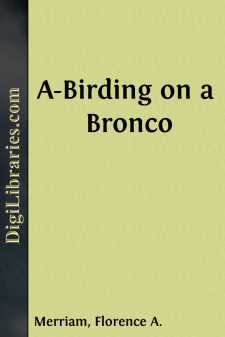Categories
- Antiques & Collectibles 13
- Architecture 36
- Art 48
- Bibles 22
- Biography & Autobiography 813
- Body, Mind & Spirit 142
- Business & Economics 28
- Children's Books 16
- Children's Fiction 13
- Computers 4
- Cooking 94
- Crafts & Hobbies 4
- Drama 346
- Education 46
- Family & Relationships 57
- Fiction 11829
- Games 19
- Gardening 17
- Health & Fitness 34
- History 1377
- House & Home 1
- Humor 147
- Juvenile Fiction 1873
- Juvenile Nonfiction 202
- Language Arts & Disciplines 88
- Law 16
- Literary Collections 686
- Literary Criticism 179
- Mathematics 13
- Medical 41
- Music 40
- Nature 179
- Non-Classifiable 1768
- Performing Arts 7
- Periodicals 1453
- Philosophy 64
- Photography 2
- Poetry 896
- Political Science 203
- Psychology 42
- Reference 154
- Religion 513
- Science 126
- Self-Help 84
- Social Science 81
- Sports & Recreation 34
- Study Aids 3
- Technology & Engineering 59
- Transportation 23
- Travel 463
- True Crime 29
A-Birding on a Bronco
Description:
Excerpt
OUR VALLEY."Climb the mountain back of the house and you can see the Pacific," the ranchman told me with a gleam in his eye; and later, when I had done that, from the top of a peak at the foot of the valley he pointed out the distant blue mountains of Mexico. Then he gave me his daughter's saddle horse to use as long as I was his guest, that I might explore the valley and study its birds to the best advantage. Before coming to California, I had known only the birds of New York and Massachusetts, and so was filled with eager enthusiasm at thought of spending the migration and nesting season in a new bird world.
I had no gun, but was armed with opera-glass and note-book, and had Ridgway's Manual to turn to in all my perplexities. Every morning, right after breakfast, my horse was brought to the door and I set out to make the rounds of the valley. I rode till dinner time, getting acquainted with the migrants as they came from the south, and calling at the more distant nests on the way. After dinner I would take my camp-stool and stroll, through the oaks at the head of the valley, for a quiet study of the nearer nests. Then once more my horse would be brought up for me to take a run before sunset; and at night I would identify my new birds and write up the notes of the day. What more could observer crave? The world was mine. I never spent a happier spring. The freedom and novelty of ranch life and the exhilaration of days spent in the saddle gave added zest to the delights of a new fauna. In my small valley circuit of a mile and a half, I made the acquaintance of about seventy-five birds, and without resort to the gun was able to name fifty-six of them.
My saddle horse, a white bronco who went by the musical name of Canello, had been broken by a Mexican whose cruelty had tamed the wild blood in his veins and left him with a fear of all swarthy skins. Now he could be ridden bareback by the little girls, with only a rope noose around his nose, and was warranted to stand still before a flock of birds so long as there was grass to eat. He was to be relied on as a horse of ripe, experience and mature judgment in matters of local danger. No power of bit or spur could induce him to set foot upon a piece of 'boggy land,' and to give me confidence one of the ranchman's sons said, "Wherever I've killed a rattlesnake from him he'll shy for years;" and went on to cite localities where a sudden, violent lurch had nearly sent him over Canello's head! What greater recommendation could I wish?
If the old horse had had any wayward impulses left, his Mexican bit would have subdued them. It would be impossible to use such an iron in the mouth of an eastern horse. They say the Mexicans sometimes break horses' jaws with it. From the middle of the bit, a flat bar of iron, three quarters of an inch wide, extended back four inches, lying on the horse's tongue or sticking into the roof of his mouth, according to the use of the curb—there was no other rein. The bit alone weighed sixteen ounces....


